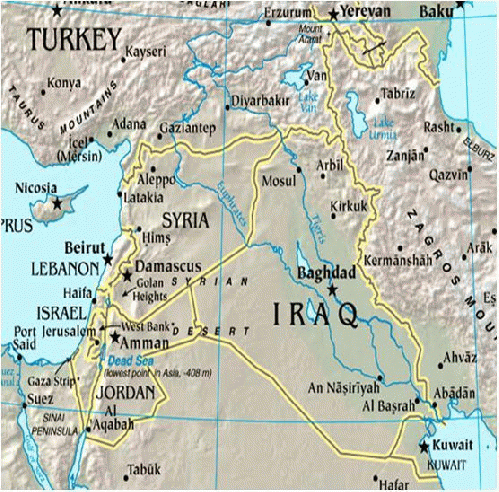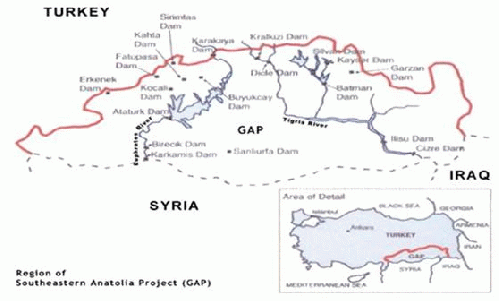One of the precipitating causes of the war in Syria (no pun intended) was the increasing scarcity of water in the Tigris-Euphrates Basin as a result of climate change and the deliberate policies of weaponization of water supplies by Turkey and its neighbour states. Drought has had a firm grip on the region since 1998 and the recent dry spell is likely the driest period on record in 900 years and almost certainly the worst drought in 500 years.
The drought during 2005 caused 75 percent of Syria's farms to fail and 85 percent of livestock to die between 2006 and 2011, according to the United Nations. The collapse in crop yields forced as many as 1.5 million Syrians to migrate to urban centres, like Homs and Damascus. [i]
The projections for the region show a continued drying trend throughout the coming century as climate change contributes to a shift in circulation patterns. That means what's happening there now could just be the start of more prolonged, more severe drought. In a region already wracked by water scarcity and conflict, more drying could ratchet up tension even further. [ii]
It was the continuing crisis over water which provided the backdrop to the Syrian Crisis. By 2011, drought-related crop failure in Syria had pushed up to 1.5 million displaced farmers to abandon their land; those displaced farmers became a wellspring of recruits for the Free Syrian Army and for such groups as the Islamic State (also called ISIS or Daesh) and al Qaeda. Testimonies gathered by reporters and activists in conflict zones suggested that the lack of government help during the drought was a central motivating factor in the anti-government rebellion in Syria. Moreover, a 2011 study shows that today's rebel strongholds of Aleppo, Deir al-Zour, and Raqqa were among the areas hardest hit by crop failure.
In other words, drought changed the economic, social, and political landscape of Syria. Iraq, already reeling from Daesh and sectarian tension, was next. In 2006, a leaked U.S. State Department cable forecast that Syria's "emerging water crisis carries the potential for severe economic volatility and even socio-political unrest." This cable was a clear warning about Iraq as well. By 2011, Iraqi wheat yields had fallen by over 50 percent. Much of the country's livestock had died, affecting hundreds of thousands of fieldworkers and farmers. Despite losing 1.6 million tons of grain to Daesh and consuming 2.5 million tons more than it can produce, Iraq had planned to become a grain exporter by 2017. This closely mirrored Syria's ambition at the time of the 2006 cable. In those years, Damascus hoped to dramatically increase agricultural production as a part of an economic diversification plan. Syria had already doubled its irrigated land in the preceding 15 years, and its 2006 five-year plan projected further increases.
In the cable, embassy officials note that agriculture experts believed that Syria's growing water demand was outstripping water availability. Despite this situation of decreased water flows the Turks continued to build dams, restricting the flows even further. Between 1975 and 1991, on three occasions, Syria and Iraq threatened Turkey with military action (and at one point they threatened each other) over reduced river flows due to dams in Turkey. Negotiations stopped and started as relations between the nations fluctuated. Since then, climate change and population growth have put extreme pressure on regional freshwater, heightening the impact of the damming of the two rivers.
One of the key players in the control of the water flows in the nations of the Fertile Crescent (Turkey, Iraq and Syria) is Turkey through which these rivers flow. In the 1960s, Turkey, Syria and Iraq negotiated a new phase of their relationship over water, as a result of Turkey's decision to construct the Keban Dam on the Euphrates. After prolonged negotiations, Turkey guaranteed to maintain a discharge of 350 m3/s immediately downstream from the dam, provided that the natural flow of the river was adequate to supply this discharge.
The price for an agreement between Turkey and Syria was that the Syrians would crack down on the large Kurdish population living near the Turkish border. [iii] The fundamental problem in this division of the waters of the Tigris-Euphrates is that the levels of water have been gradually diminishing and water shortages are an ever-growing problem for Syria and Iraq.[iii] Since 1975, Turkey's extensive dam and hydropower construction has reportedly reduced water flows into Iraq and Syria by approximately 80 per cent and 40 per cent respectively. Approximately 90 per cent of the water flow in the Euphrates and 50 per cent in the Tigris originate in Turkey. This has left Syria and Iraq vulnerable.
The Turks only use about 35% of the water flow and this is largely because it manages the flow through an elaborate system of dams. The pieÌ?ce de reÌ �sistance of the program of dam-building in Turkey was the gigantic Southern Anatolian Project (known by its Turkish acronym, GAP), which commenced in the 1970s and encompasses 22 dams, 19 hydroelectric power plants and several irrigation networks. GAP remains the second biggest integrated water development project in the world, covering approximately 10 percent of Turkey's population and an equivalent surface area. [iv]
This situation was made critical with the rise of Daesh. The ongoing spread of Daesh across the region has ended up with Daesh seizing control of water resources in both Syria and Iraq. Daesh is able to use water structures as a means to prevent local populations (especially near Baghdad and the Shiite population inhabiting the southern part of Iraq) from accessing water. However, Daesh in northern Syria and near Mosul in Iraq are dependent on water flows from Turkey. This means that there is a limited amount of pressure that either Iraq or Syria (and Daesh as well) can apply to Turkey without risking a severe shortage of water.
(Note: You can view every article as one long page if you sign up as an Advocate Member, or higher).






